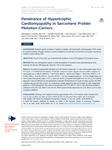Penetrance of Hypertrophic Cardiomyopathy in Sarcomere Protein Mutation Carriers

Use this link to cite
http://hdl.handle.net/2183/26216Collections
- Investigación (FEP) [507]
Metadata
Show full item recordTitle
Penetrance of Hypertrophic Cardiomyopathy in Sarcomere Protein Mutation CarriersAuthor(s)
Date
2020-07-27Citation
Lorenzini M, Norrish G, Field G, et al. Penetrance of Hypertrophic Cardiomyopathy in Sarcomere Protein Mutation Carriers. J. Am. Coll. Cardiol. 2020; 76(5):550-559
Abstract
[Abstract]
Background.
Predictive genetic screening of relatives of patients with hypertrophic cardiomyopathy (HCM) caused by sarcomere protein (SP) gene mutations is current standard of care, but there are few data on long-term outcomes in mutation carriers without HCM.
Objectives.
The aim of this study was to determine the incidence of new HCM diagnosis in SP mutation carriers.
Methods.
This was a retrospective analysis of adult and pediatric SP mutation carriers identified during family screening who did not fulfill diagnostic criteria for HCM at first evaluation.
Results.
The authors evaluated 285 individuals from 156 families (median age 14.2 years [interquartile range: 6.8 to 31.6 years], 141 [49.5%] male individuals); 145 (50.9%) underwent cardiac magnetic resonance (CMR). Frequency of causal genes was as follows: MYBPC3 n = 123 (43.2%), MYH7 n = 69 (24.2%), TNNI3 n = 39 (13.7%), TNNT2 n = 34 (11.9%), TPM1 n = 9 (3.2%), MYL2 n = 6 (2.1%), ACTC1 n = 1 (0.4%), multiple mutations n = 4 (1.4%). Median follow-up was 8.0 years (interquartile range: 4.0 to 13.3 years) and 86 (30.2%) patients developed HCM; 16 of 50 (32.0%) fulfilled diagnostic criteria on CMR but not echocardiography. Estimated HCM penetrance at 15 years of follow-up was 46% (95% confidence interval [CI]: 38% to 54%). In a multivariable model adjusted for age and stratified for CMR, independent predictors of HCM development were male sex (hazard ratio [HR]: 2.91; 95% CI: 1.82 to 4.65) and abnormal electrocardiogram (ECG) (HR: 4.02; 95% CI: 2.51 to 6.44); TNNI3 variants had the lowest risk (HR: 0.19; 95% CI: 0.07 to 0.55, compared to MYBPC3).
Conclusions.
Following a first negative screening, approximately 50% of SP mutation carriers develop HCM over 15 years of follow-up. Male sex and an abnormal ECG are associated with a higher risk of developing HCM. Regular CMR should be considered in long-term screening.
Keywords
Cardiac magnetic resonance
ECG
Echocardiogram
Sex
Sudden cardiac death
ECG
Echocardiogram
Sex
Sudden cardiac death
Editor version
Rights
Atribución 4.0 España
ISSN
0735-1097
1558-3597
1558-3597






